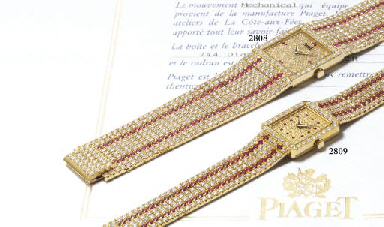A fine and impressive George II/III mahogany eight-day longcase clock with fly-back perpetual annual calendar, Tuler for Roger Rice, Bristol, mid 18th century The five pillar rack and bell striking movement with anchor escapement regulated by seconds pendulum and bold engraved signature Juler, Fecit towards the lower margin of the frontplate, the fly-back perpetual calendar mechanism applied to the rear of the arch of the dial plate and advanced by the motionwork via a lever engaging with a lug applied to a cannon wheel fitted over the seconds arbor, the 12 inch brass break-arch dial with subsidiary seconds dial and shaped foliate scroll decorated signature cartouche engraved R. Rice Bristol to the matted centre within applied silvered Roman numeral chapter ring with arcaded minute divisions and Arabic five minutes to outer track, with pierced steel hands and unusual female mask and scroll cast spandrels to angles beneath arch centred with steel pointer and pierced radial solar lunette incorporating mask to the disc and further hatched radial points to a silvered plate behind, the upper margin with curved calendar scale annotated with Arabic numerals for every three days, in an impressive mahogany swan neck pedimented case with giltwood relief carved foliate break-arch band to the blind fret fronted box upstand over wavy-outline glazed dial aperture to the hood door flanked by Corinthian columns with cast brass caps and bases, the sides with conforming half columns set beside bargeboards at the rear, the trunk with shaped-top wavy panel applied caddy moulded door flanked by stop-fluted Corinthian quarter columns, on raised square hipped panel fronted plinth base incorporating wavy surround and flanked by canted angles carved with quoins over deep skirt and squat ogee bracket feet, 254cm (100ins) high to apex of swan neck. Roger Rice is recorded in Moore, A. J. THE CLOCKMAKERS OF BRISTOL 1650-1900 as a probably principally a brass and ironfounder who was known to have been working in 1740 and 1741. Moore further notes that clockmaking was probably a sideline. A maker with the surname Juler appears not to be recorded in the usual sources as working in Bristol at this time, however online sources suggest that there was a Matthew Juler working as a clockmaker in the suburb of Bedminster at some point. The movement of the current clock is of the finest quality with refinements such as thick plates and generous boldly turned pillars, massive greatwheels incorporating concealed winding clicks and locking of the strike train via a tail on the rack hook engaging with the warning wheel. In addition to the extraordinary perpetual annual calendar work the dial is extremely original in its design and execution with bold statements such as the layered sunburst motif in the arch and arcaded minutes to the chapter ring which incidentally is secured to the dial plate with six feet rather than the usual four - again demonstrating the maker's high quality approach. The case compliments the movement perfectly and exhibits iconic Bristol features such as two-tier pediment, wavy-outline dial aperture and conforming border to the trunk door. The base is extraordinary as it develops the regional Bristol style even further by incorporating a shallow hipped pyramid panel to the centre flanked by elaborate carved quoins to the canted angles.
A fine and impressive George II/III mahogany eight-day longcase clock with fly-back perpetual annual calendar, Tuler for Roger Rice, Bristol, mid 18th century The five pillar rack and bell striking movement with anchor escapement regulated by seconds pendulum and bold engraved signature Juler, Fecit towards the lower margin of the frontplate, the fly-back perpetual calendar mechanism applied to the rear of the arch of the dial plate and advanced by the motionwork via a lever engaging with a lug applied to a cannon wheel fitted over the seconds arbor, the 12 inch brass break-arch dial with subsidiary seconds dial and shaped foliate scroll decorated signature cartouche engraved R. Rice Bristol to the matted centre within applied silvered Roman numeral chapter ring with arcaded minute divisions and Arabic five minutes to outer track, with pierced steel hands and unusual female mask and scroll cast spandrels to angles beneath arch centred with steel pointer and pierced radial solar lunette incorporating mask to the disc and further hatched radial points to a silvered plate behind, the upper margin with curved calendar scale annotated with Arabic numerals for every three days, in an impressive mahogany swan neck pedimented case with giltwood relief carved foliate break-arch band to the blind fret fronted box upstand over wavy-outline glazed dial aperture to the hood door flanked by Corinthian columns with cast brass caps and bases, the sides with conforming half columns set beside bargeboards at the rear, the trunk with shaped-top wavy panel applied caddy moulded door flanked by stop-fluted Corinthian quarter columns, on raised square hipped panel fronted plinth base incorporating wavy surround and flanked by canted angles carved with quoins over deep skirt and squat ogee bracket feet, 254cm (100ins) high to apex of swan neck. Roger Rice is recorded in Moore, A. J. THE CLOCKMAKERS OF BRISTOL 1650-1900 as a probably principally a brass and ironfounder who was known to have been working in 1740 and 1741. Moore further notes that clockmaking was probably a sideline. A maker with the surname Juler appears not to be recorded in the usual sources as working in Bristol at this time, however online sources suggest that there was a Matthew Juler working as a clockmaker in the suburb of Bedminster at some point. The movement of the current clock is of the finest quality with refinements such as thick plates and generous boldly turned pillars, massive greatwheels incorporating concealed winding clicks and locking of the strike train via a tail on the rack hook engaging with the warning wheel. In addition to the extraordinary perpetual annual calendar work the dial is extremely original in its design and execution with bold statements such as the layered sunburst motif in the arch and arcaded minutes to the chapter ring which incidentally is secured to the dial plate with six feet rather than the usual four - again demonstrating the maker's high quality approach. The case compliments the movement perfectly and exhibits iconic Bristol features such as two-tier pediment, wavy-outline dial aperture and conforming border to the trunk door. The base is extraordinary as it develops the regional Bristol style even further by incorporating a shallow hipped pyramid panel to the centre flanked by elaborate carved quoins to the canted angles.
.jpg)














Testen Sie LotSearch und seine Premium-Features 7 Tage - ohne Kosten!
Lassen Sie sich automatisch über neue Objekte in kommenden Auktionen benachrichtigen.
Suchauftrag anlegen